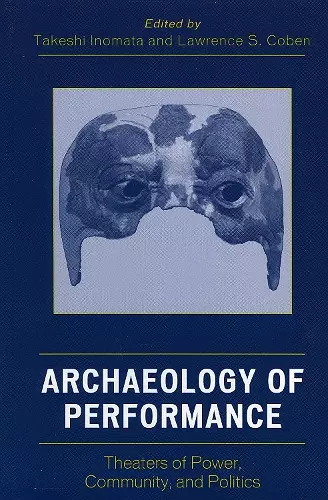Archaeology of Performance
Theaters of Power, Community, and Politics
Takeshi Inomata editor Lawrence S Coben editor
Format:Hardback
Publisher:AltaMira Press
Published:9th Mar '06
Currently unavailable, and unfortunately no date known when it will be back
This hardback is available in another edition too:
- Paperback£52.00(9780759108776)

Performances in the premodern communities shaped identities, created meanings, generated and maintained political control. But unlike other social scientists, archaeologists have not worked much with these concepts. Archaeology of Performance shows how the notions of theatricality and spectacle are as important economics and politics in understanding how ancient communities work. Without sacrificing conceptual rigor, the contributors draw on the wide-ranging literature on performance. Without sacrificing material evidence, they try to see how performance creates meaning and ideology. Drawing on evidence from societies large and small, Archaeology of Performance offers an important new ways of understanding ancient theaters of power.
From the theatres of Inka power and ancient Egyptian ceremonies to Mayan spectacles and an Anatolian “festival of death and consumption,” this book is exemplary of a new and powerful archeology of performance. Using the tools of archeology, forensics, and performance theory, the authors of this collection lucidly explore theatre, the performative body, and ritual. What theyfind is not a “dead past” but rich repositories of living performances. Archeology of Performance is a must read for scholars in performance and the social sciences. Artists, too, will learn from this pioneering book. -- Richard Schechner, Professor of Performance Studies, Tisch School of the Arts, NYU
<Archaeology of Performance> expands archaeologists' long-term interest in ritual with critical scrutiny and theorization about the settings for public performance and performance-as-spectacle. In a global and temporally deep series of essays ranging fromthe 9500-year-old settlement at Catalhoyuk in central Turkey to Pueblo society of the U.S. southwest in the early 20th century, the ten contributing authors focus our attention on the theatrical characteristics of ritual and political spaces and their communicative qualities. The inter-referencing agreements and debates provide an unusual degree of dialogue among the chapters. Cleverly organized in acts and scenes, the volume introduces the reader to an extensive, but previously diffuse, literature,which is deployed in highly creative analyses of substantial data sets. The many stimulating ideas put forth by the scholars will surely lead to encore performances by them and raise the curtain on a new generation of research in this highly dynamic,embodied, place-marking field. Emphasizing the negotiated construction of identity, constitution of community, production of memory, and contestation of power relations, <Archaeology of Performance> will be widely read and applied in the study of social c -- Helaine Silverman, Professor, Department of Anthropology, University of Illinois (Urbana)
expands archaeologists' long-term interest in ritual with critical scrutiny and theorization about the settings for public performance and performance-as-spectacle. In a global and temporally deep series of essays ranging from the 9500-year-old settlement at Catalhoyuk in central Turkey to Pueblo society of the U.S. southwest in the early 20th century, the ten contributing authors focus our attention on the theatrical characteristics of ritual and political spaces and their communicative qualities. The inter-referencing agreements and debates provide an unusual degree of dialogue among the chapters. Cleverly organized in "acts" and "scenes," the volume introduces the reader to an extensive, but previously diffuse, literature, which is deployed in highly creative analyses of substantial data sets. The many stimulating ideas put forth by the scholars will surely lead to "encore performances" by them and "raise the curtain" on a new generation of research in this highly dynamic, embodied, place-marking field. Emphasizing the negotiated construction of identity, constitution of community, production of memory, and contestation of power relations, will be widely read and applied in the study of social complexity and processes of political centralization. -- Helaine Silverman, Professor, Department of Anthropology, University of Illinois (Urbana)
ISBN: 9780759108769
Dimensions: 236mm x 164mm x 28mm
Weight: 667g
352 pages